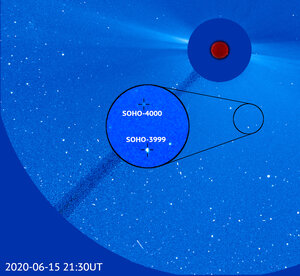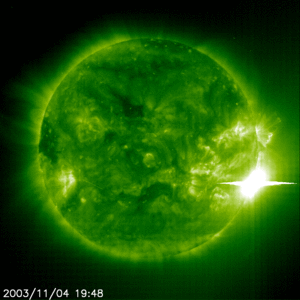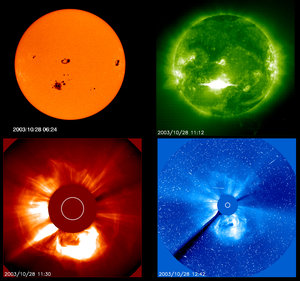SOHO’s ten-year triumph in unmasking the Sun
Thanks to one of the most productive spacecraft ever built, scientists are far better acquainted with the star that lights our world and gives us life. Built for ESA by European industry, the Solar and Heliospheric Observatory (SOHO) went into space on 2 December 1995.
The tenth anniversary of SOHO’s launch is a time for celebration for the scientists and engineers in Europe and the USA who conceived, created and still operate this unprecedented solar spacecraft – and who have rescued it from oblivion three times.
Four months after its flawless launch by a NASA rocket, SOHO was at its special vantage point 1.5 million kilometres away from the sunward side of Earth. There it watches the Sun unblinkingly 24 hours every day, and sends home a stream of images of the ceaseless frenzy in the solar atmosphere.
Apart from unmasking the Sun, and teaching us how it works, SOHO’s pictures give early warning of storms in space that can affect astronauts, satellites and power and communications systems on Earth.

Originally planned for a nominal life of just two years, SOHO has performed so well and delivered such important data that operations are now to set to continue at least until 2007.
That corresponds to a full 11-year cycle of magnetic storms on the Sun, and a further extension is under discussion. But the going has not always been easy.
All contact was lost with the spacecraft in June 1998. Dramatic efforts by ESA and NASA engineers, supported by Matra Marconi Space (now Astrium) who built SOHO, restored the spacecraft to full operation in November 1998.
Shortly afterwards, the spacecraft’s last gyroscope failed, but the teams developed new software that controls the spacecraft without a gyroscope. A third crisis occurred in June 2003, when SOHO’s main antenna became stuck. Using the secondary antenna and software for intermittent recording, observations continued.
"I tip my hat to SOHO’s engineering and operations teams, whose skills and dedication let us overcome all these challenges," says Bernhard Fleck, ESA’s Project Scientist for SOHO.
More than 3200 scientists from around the world have been involved with SOHO, which is a project of international collaboration between ESA and NASA. SOHO’s telescopes probe the Sun from deep in its interior and all the way out to Earth’s orbit and beyond, where the magnetised solar wind of atomic particles sweeps through interplanetary space.
For more information:
Bernhard Fleck, ESA SOHO Project Scientist
E-mail: bfleck @ esa.nascom.nasa.gov















 Germany
Germany
 Austria
Austria
 Belgium
Belgium
 Denmark
Denmark
 Spain
Spain
 Estonia
Estonia
 Finland
Finland
 France
France
 Greece
Greece
 Hungary
Hungary
 Ireland
Ireland
 Italy
Italy
 Luxembourg
Luxembourg
 Norway
Norway
 The Netherlands
The Netherlands
 Poland
Poland
 Portugal
Portugal
 Czechia
Czechia
 Romania
Romania
 United Kingdom
United Kingdom
 Slovenia
Slovenia
 Sweden
Sweden
 Switzerland
Switzerland


































